I. The Real Economy - ആർബിഐ - Reserve Bank of India
I. The Real Economy
Growth Rates
The Indian economy exhibited a strong performance during 2005-06, led by sustained growth in the industry and the services sectors. According to the advance estimates of the Central Statistical Organisation (CSO), real GDP growth accelerated from 7.5 per cent in 2004-05 to 8.1 per cent in 2005-06 (Table 1). Growth in industry was propelled by the manufacturing activity which more than offset the deceleration in ‘mining and quarrying’. The services sector, which recorded double-digit growth for the second successive year, continued to be the major driver of economic activity, contributing almost three-fourth of overall real GDP growth during 2005-06 (Chart 1). Within the services sector, ‘trade, hotels, transport and communication’ and
| Table 1: Growth Rates of Real GDP (Base Year: 1999-2000) |
||||||||||||||
| (Per cent) |
||||||||||||||
| Sector |
2000-01 |
2003- |
2004- |
2005- |
2004-05 |
2005-06 |
2004- |
2005- |
||||||
| to |
04* |
05# |
06@ |
05 |
06 |
|||||||||
| Q1 |
Q2 |
Q3 |
Q1 |
Q2 |
Q3 |
|||||||||
| 2002-03 |
||||||||||||||
| First Three |
||||||||||||||
| (Average) |
||||||||||||||
| Quarters |
||||||||||||||
| 1 |
2 |
3 |
4 |
5 |
6 |
7 |
8 |
9 |
10 |
11 |
12 |
13 |
||
| 1. |
Agriculture and Allied |
-0.2 |
10.0 |
0.7 |
2.3 |
3.5 |
-0.2 |
-1.2 |
1.4 |
2.4 |
3.4 |
0.5 |
2.5 |
|
| Activities |
(24.7) |
(22.2) |
(20.8) |
(19.7) |
||||||||||
| 1.1 Agriculture |
-0.5 |
10.7 |
0.7 |
.. |
||||||||||
| 2. |
Industry |
5.2 |
6.6 |
7.4 |
8.0 |
6.6 |
8.0 |
8.1 |
9.9 |
6.7 |
7.1 |
7.6 |
7.9 |
|
| (19.6) |
(19.5) |
(19.5) |
(19.5) |
|||||||||||
| 2.1 |
Mining and Quarrying |
4.4 |
5.3 |
5.8 |
1.0 |
8.2 |
6.0 |
5.7 |
3.7 |
-1.9 |
0.6 |
6.6 |
0.8 |
|
| 2.2 |
Manufacturing |
5.7 |
7.1 |
8.1 |
9.4 |
6.6 |
8.3 |
9.2 |
11.3 |
8.6 |
8.4 |
8.1 |
9.4 |
|
| 2.3 |
Electricity, Gas and |
|||||||||||||
| Water Supply |
2.8 |
4.8 |
4.3 |
5.4 |
4.9 |
7.9 |
3.1 |
6.9 |
2.2 |
4.4 |
5.3 |
4.5 |
||
| 3. |
Services |
6.6 |
8.5 |
10.2 |
10.1 |
10.1 |
8.4 |
10.7 |
10.0 |
10.0 |
9.7 |
9.7 |
9.9 |
|
| (55.8) |
(58.3) |
(59.7) |
(60.9) |
|||||||||||
| 3.1 |
Trade, Hotels, |
|||||||||||||
| Restaurants, |
||||||||||||||
| Transport, Storage |
||||||||||||||
| and Communication |
8.5 |
12.0 |
10.6 |
11.1 |
10.6 |
11.2 |
9.7 |
11.7 |
11.2 |
10.3 |
10.5 |
11.0 |
||
| 3.2 |
Financing, Insurance, |
|||||||||||||
| Real Estate and |
||||||||||||||
| Business Services |
6.5 |
4.5 |
9.2 |
9.5 |
8.8 |
7.5 |
9.7 |
8.7 |
9.8 |
9.1 |
8.7 |
9.2 |
||
| 3.3 |
Community, Social |
|||||||||||||
| and Personal Services |
4.1 |
5.4 |
9.2 |
7.9 |
10.7 |
4.8 |
8.5 |
7.0 |
7.3 |
8.1 |
7.9 |
7.5 |
||
| 3.4 |
Construction |
5.9 |
10.9 |
12.5 |
12.1 |
9.9 |
7.9 |
22.0 |
12.4 |
12.3 |
11.5 |
13.3 |
12.0 |
|
| 4. |
Real GDP at Factor Cost |
4.6 |
8.5 |
7.5 |
8.1 |
7.9 |
6.7 |
7.0 |
8.1 |
8.0 |
7.6 |
7.2 |
7.9 |
|
| * : Provisional Estimates. # : Quick Estimates. @ : Advance Estimates. |
||||||||||||||
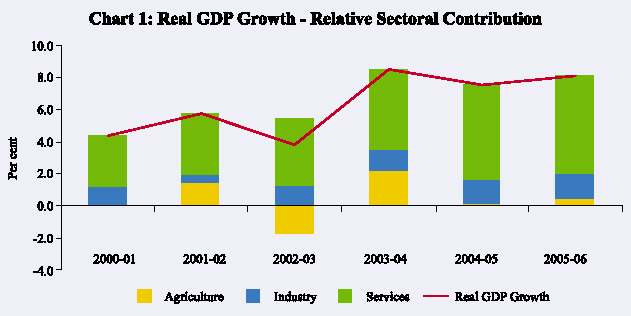
‘construction’ sub-sectors exhibited double-digit growth rates for the third consecutive year. Growth of real GDP originating from ‘agriculture and allied activities’ is expected to register a modest pick-up, following satisfactory spatial distribution of South-West monsoon and higher kharif production.
Agricultural Situation
Agricultural production during 2005-06 is expected to improve due to satisfactory rainfall and moisture conditions during the year. According to the India Meteorological Department, the cumulative rainfall during the South-West monsoon 2005 was one per cent below normal (i.e., Long Period Average) as compared with 13 per cent below normal during the previous year. Although the rainfall was initially weak, it picked up from the last week of June 2005, offsetting the deficiency registered during the early part of the season. Of the 36 meteorological sub-divisions, cumulative rainfall was excess/normal in 32 subdivisions (23 sub-divisions during last year). The progress of the North-East monsoon (October 1 to December 31) was also satisfactory with the cumulative rainfall at 10 per cent above normal as compared with 11 per cent below normal during the previous year. Of the 36 meteorological sub-divisions, cumulative rainfall was excess/normal in 17 sub-divisions (18 sub-divisions during last year) and deficient/scanty/no rain in 19 sub-divisions (18 sub-divisions during last year) (Chart 2). The total reservoir capacity as on April 7, 2006 in the 76 major reservoirs1 monitored by the Central Water Commission at 45.3 billion cubic meters (BCM) was 34 per cent of the full reservoir level (FRL) and 147 per cent of the last year’s level.
1 These reservoirs account for 63 per cent of the total reservoir capacity of the country.
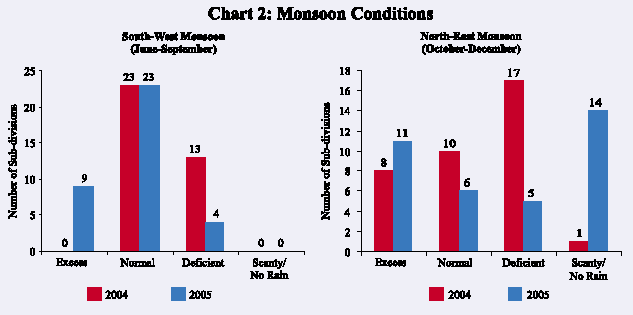
The satisfactory progress of monsoon during 2005-06 facilitated some improvement in area coverage under crops. While the area under kharif crops was 1.2 per cent higher than a year ago, that under rabi crops was 4.1 per cent higher (Table 2).
| Table 2: Progress of Area under Crops - 2005-06 |
||||||||||
| (Million Hectares) |
||||||||||
| Crop |
Normal |
Area Coverage |
Crop |
Normal |
Area Coverage |
|||||
| Area |
Area |
|||||||||
| 2004 |
2005 |
Variation |
2004 |
2005 |
Variation |
|||||
| (2005 over |
(2005 over |
|||||||||
| 2004) |
2004) |
|||||||||
| (Per cent) |
(Per cent) |
|||||||||
| 1 |
2 |
3 |
4 |
5 |
1 |
2 |
3 |
4 |
5 |
|
| Kharif |
Crops |
Rabi |
Crops (As on March 27, 2006) |
|||||||
| Rice |
39.9 |
35.5 |
37.1 |
4.6 |
Wheat |
26.3 |
26.5 |
26.7 |
0.8 |
|
| Coarse Cereals |
22.9 |
22.5 |
21.9 |
-2.5 |
Rice |
3.8 |
4.0 |
4.9 |
23.1 |
|
| of which: |
||||||||||
| Coarse Cereals |
6.5 |
7.0 |
6.9 |
2.3 |
||||||
| Bajra |
9.3 |
9.1 |
8.2 |
-9.4 |
||||||
| of which: |
||||||||||
| Jowar |
4.6 |
3.9 |
3.8 |
-3.3 |
||||||
| Jowar |
5.1 |
5.1 |
5.1 |
-1.1 |
||||||
| Maize |
6.0 |
7.0 |
7.3 |
5.2 |
||||||
| Maize |
0.7 |
0.7 |
0.7 |
-1.7 |
||||||
| Pulses |
10.6 |
11.2 |
11.4 |
1.4 |
||||||
| Barley |
0.7 |
0.7 |
0.8 |
18.1 |
||||||
| Oilseeds |
15.1 |
18.0 |
17.6 |
-2.6 |
||||||
| Oilseeds |
7.8 |
10.8 |
11.4 |
4.0 |
||||||
| of which: |
||||||||||
|
of which: |
||||||||||
| Groundnut |
5.5 |
5.8 |
5.6 |
-3.1 |
||||||
| Soyabean |
6.3 |
8.0 |
7.7 |
-3.1 |
Rapeseed and Mustard 5.1 |
7.1 |
7.3 |
2.8 |
||
| Sesamum |
1.6 |
2.0 |
1.9 |
-6.4 |
Groundnut |
0.8 |
1.0 |
1.2 |
18.2 |
|
| Niger |
0.5 |
0.5 |
0.4 |
-15.8 |
Sunflower |
1.0 |
1.3 |
1.4 |
5.4 |
|
| Cotton |
8.3 |
8.6 |
8.6 |
0.0 |
Sesamum |
1.6 |
0.3 |
0.3 |
-4.4 |
|
| Sugarcane |
4.3 |
3.8 |
4.1 |
10.3 |
Linseed |
0.5 |
0.6 |
0.6 |
0.0 |
|
| All Crops |
101.9 |
100.4 |
101.6 |
1.2 |
All Crops |
55.5 |
61.1 |
63.6 |
4.1 |
|
| Source : Ministry of Agriculture, Government of India. |
||||||||||
| Table 3: Agricultural Production |
|||||||
| (Million Tonnes) |
|||||||
| Crop |
2003-04 |
2004-05 |
2005-06 |
||||
| T |
A |
T |
A $ |
T |
A $$ |
||
| 1 |
2 |
3 |
4 |
5 |
6 |
7 |
|
| Rice |
87.0 |
88.3 |
93.5 |
85.3 |
87.8 |
87.9 |
|
| Wheat |
72.1 |
72.1 |
79.5 |
72.0 |
75.5 |
73.1 |
|
| Coarse Cereals |
37.8 |
38.1 |
36.8 |
33.9 |
36.5 |
34.0 |
|
| Pulses |
15.2 |
14.9 |
15.3 |
13.4 |
15.2 |
14.4 |
|
| Kharif |
112.0 |
116.9 |
113.8 |
103.3 |
109.9 |
108.2 |
|
| Rabi |
100.0 |
96.6 |
111.3 |
101.3 |
105.1 |
101.2 |
|
| Total Foodgrains |
212.1 |
213.5 |
225.1 |
204.6 |
215.0 |
209.3 |
|
| Oilseeds |
|||||||
| Kharif |
17.0 |
16.8 |
16.3 |
14.9 |
16.2 |
16.0 |
|
| Rabi |
8.1 |
8.5 |
9.9 |
11.2 |
10.4 |
10.4 |
|
| Total Oilseeds |
25.1 |
25.3 |
26.2 |
26.1 |
26.6 |
26.4 |
|
| Sugarcane |
236.2 |
237.3 |
270.0 |
232.3 |
237.5 |
266.9 |
|
| Cotton # |
13.8 |
13.9 |
15.0 |
17.0 |
16.5 |
16.5 |
|
| Jute and Mesta ## |
11.2 |
11.2 |
11.8 |
10.5 |
11.3 |
10.7 |
|
| T : Target A: Achievement. $ : Fourth Advance Estimate. |
|||||||
Total foodgrains production during 2005-06 is estimated at 209 million tonnes, an increase of 2.3 per cent over the previous year led by higher output of rice, wheat, maize and pulses. Among non-foodgrains crops, the production of sugarcane, oilseeds and jute is expected to increase, whereas that of cotton and mesta is likely to be lower than the previous year (Table 3).
Food Management
Total procurement of rice and wheat during 2005-06 (up to March 27, 2006) aggregated 41.1 million tonnes, marginally higher (0.9 per cent) than the previous year. The off-take of rice and wheat during 2005-06 (April 1 to January 31, 2006) was 33.0 million tonnes, which was 1.1 per cent lower than a year ago (33.3 million tonnes). The total stock of foodgrains with the Food Corporation of India (FCI) and the State agencies was 19.5 million tonnes as on February 1, 2006, 9.5 per cent lower than a year ago. The decline was mainly on account of wheat stocks, which fell to 4.9 million tonnes from 7.3 million tonnes a year ago. The stock of foodgrains as on February 1, 2006 was lower than the buffer norm of 20 million tonnes. While the stock of rice was higher than the norm (11.8 million tonnes), the stock of wheat was 3.3 million tonnes less than the norm (8.2 million tonnes) (Table 4).
| Table 4: Management of Food Stocks |
|||||||||||||
| (Million Tonnes) |
|||||||||||||
| Opening Stock of |
Procurement of |
Foodgrains Off-take |
Closing |
Norms |
|||||||||
| Foodgrains |
Foodgrains |
Stock |
|||||||||||
| Month |
Rice |
Wheat |
Total |
Rice |
Wheat |
Total |
PDS |
OWS |
OMS - |
Exports |
Total |
||
| Domestic |
|||||||||||||
| 1 |
2 |
3 |
4 |
5 |
6 |
7 |
8 |
9 |
10 |
11 |
12 |
13 |
14 |
| 2004 |
|||||||||||||
| January |
11.7 |
12.7 |
25.0 |
3.5 |
0.0 |
3.5 |
2.4 |
0.9 |
0.2 |
0.4 |
3.8 |
24.0 |
16.8 |
| February |
12.4 |
11.0 |
24.0 |
2.2 |
0.0 |
2.2 |
1.9 |
1.1 |
0.1 |
0.5 |
3.7 |
22.8 |
|
| March |
13.6 |
8.6 |
22.8 |
2.1 |
0.0 |
2.1 |
2.5 |
1.2 |
0.1 |
0.4 |
4.2 |
20.6 |
|
| April |
13.1 |
6.9 |
20.6 |
1.2 |
14.5 |
15.7 |
2.0 |
0.5 |
0.0 |
0.3 |
2.9 |
32.4 |
15.8 |
| May |
12.7 |
19.0 |
32.4 |
1.3 |
1.7 |
3.0 |
2.3 |
0.6 |
0.0 |
0.1 |
3.0 |
32.3 |
|
| June |
12.3 |
19.4 |
32.3 |
0.9 |
0.5 |
1.4 |
2.3 |
1.0 |
0.0 |
0.1 |
3.5 |
30.6 |
|
| July |
10.8 |
19.2 |
30.6 |
0.4 |
0.1 |
0.5 |
2.4 |
1.0 |
0.0 |
0.1 |
3.6 |
27.2 |
24.3 |
| August |
9.1 |
17.4 |
27.2 |
0.5 |
0.0 |
0.2 |
2.4 |
1.0 |
0.0 |
0.1 |
3.4 |
23.0 |
|
| September |
7.1 |
15.8 |
23.0 |
0.2 |
0.0 |
0.2 |
2.5 |
1.0 |
0.0 |
0.1 |
3.7 |
20.3 |
|
| October |
6.1 |
14.2 |
20.3 |
7.4 |
0.0 |
6.5 |
2.4 |
0.8 |
0.0 |
0.0 |
3.2 |
23.7 |
18.1 |
| November |
11.0 |
12.6 |
23.7 |
1.9 |
0.0 |
2.7 |
2.4 |
0.6 |
0.0 |
0.0 |
3.1 |
21.8 |
|
| December |
11.1 |
10.7 |
21.8 |
3.2 |
0.0 |
2.6 |
2.6 |
0.7 |
0.0 |
0.0 |
3.4 |
21.7 |
|
| 2005 |
|||||||||||||
| January |
12.8 |
8.9 |
21.7 |
3.9 |
0.0 |
3.9 |
2.7 |
0.8 |
0.0 |
0.0 |
3.5 |
21.5 |
16.8 |
| February |
14.2 |
7.3 |
21.5 |
2.3 |
0.0 |
2.3 |
2.7 |
0.9 |
0.0 |
0.0 |
3.7 |
20.0 |
|
| March |
13.7 |
5.8 |
20.0 |
1.7 |
0.0 |
1.7 |
2.7 |
1.7 |
0.0 |
0.0 |
4.4 |
18.0 |
|
| April |
13.3 |
4.1 |
18.0 |
1.2 |
12.8 |
14.0 |
2.4 |
1.0 |
0.0 |
0.0 |
3.4 |
28.5 |
16.2 |
| May |
13.0 |
15.1 |
28.5 |
1.2 |
2.0 |
3.1 |
2.5 |
0.8 |
0.0 |
0.0 |
3.3 |
27.9 |
|
| June |
11.6 |
15.7 |
27.9 |
0.8 |
0.1 |
0.9 |
2.5 |
1.7 |
0.0 |
0.0 |
4.2 |
25.1 |
|
| July |
10.1 |
14.5 |
25.1 |
0.4 |
0.0 |
0.4 |
2.8 |
0.8 |
0.1 |
0.0 |
3.6 |
21.4 |
26.9 |
| August |
8.0 |
13.0 |
21.4 |
0.9 |
0.0 |
0.9 |
2.6 |
0.8 |
0.1 |
0.0 |
3.4 |
18.4 |
|
| September |
6.4 |
11.6 |
18.4 |
0.4 |
0.0 |
0.4 |
2.7 |
0.7 |
0.1 |
0.0 |
3.5 |
15.5 |
|
| October |
4.8 |
10.3 |
15.5 |
7.6 |
0.0 |
7.6 |
2.2 |
0.5 |
0.0 |
0.0 |
2.7 |
19.8 |
16.2 |
| November |
10.3 |
9.1 |
19.8 |
2.7 |
0.0 |
2.7 |
1.8 |
0.5 |
0.1 |
0.0 |
2.4 |
19.0 |
|
| December |
11.1 |
7.6 |
19.0 |
3.4 |
0.0 |
3.4 |
2.3 |
0.7 |
0.2 |
0.0 |
3.2 |
19.3 |
|
| 2006 |
|||||||||||||
| January |
12.6 |
6.2 |
19.3 |
3.8 |
0.0 |
3.8 |
2.3 |
0.8 |
0.1 |
0.0 |
3.2 |
19.5 |
20.0 |
| February |
14.0 |
4.9 |
19.5 |
2.5 |
0.0 |
2.5 |
N.A. |
N.A. |
N.A. |
N.A. |
N.A. |
N.A. |
|
| March* |
N.A. |
N.A. |
N.A. |
1.5 |
0.0 |
1.5 |
N.A. |
N.A. |
N.A. |
N.A. |
N.A. |
N.A. |
|
| PDS : Public Distribution System. OWS : Other Welfare Schemes. |
|||||||||||||
Industrial Performance
Industrial production registered strong growth during April-February 2005-06 on the back of robust and broad-based manufacturing activity (Chart 3). The manufacturing sector recorded a growth of 9.0 per cent in 2005-06 (April-
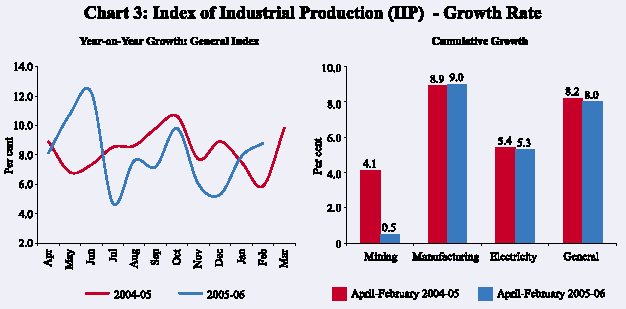
February) on top of 8.9 per cent rise a year ago. It accounted for 93.4 per cent of the overall industrial sector growth. The mining sector witnessed a sharp deceleration in growth, largely attributable to the decline in production of crude oil on account of break-out of fire in the Mumbai-High oil field in July 2005 as well as subdued mining activity in respect of some metallic minerals. The electricity sector recorded a marginal deceleration, reflecting shortage of coal and gas.
In terms of the use-based classification, capital and consumer goods sectors maintained their high growth momentum during April-February 2005-06 (Chart 4). In consonance with the pick-up in investment activity in the economy,
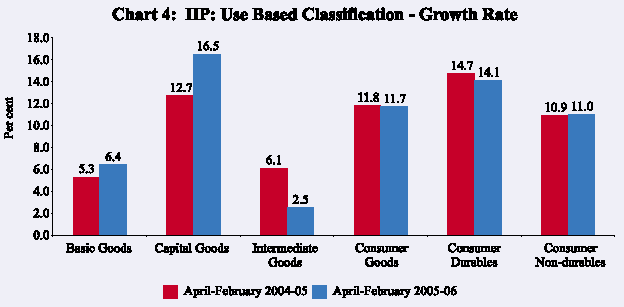
| Table 5: Performance of Manufacturing Industry Groups: 2005-06 (April-February) |
|||||
| Acceleration in Growth |
Deceleration in Growth |
Negative Growth |
|||
| 1. |
Other manufacturing industries |
1. |
Machinery and equipment other |
1. |
Metal products and parts |
| (24.3) |
than transport equipment (11.7) |
(except machinery and |
|||
| equipment) (-1.3) |
|||||
| 2. |
Textiles products (including |
2. |
Chemicals and chemical products |
||
| apparels) (18.8) |
(8.5) |
2. |
Leather and leather and fur |
||
| products (-5.0) |
|||||
| 3. |
Beverages, tobacco and related |
3. |
Jute and other vegetable fibre |
||
| products (14.8) |
(1.0) |
3. |
Wood and wood products, |
||
| furniture and fixtures (-5.6) |
|||||
| 4. |
Basic metal and alloy industries |
4. |
Paper and paper products and |
||
| (14.7) |
printing, publishing and allied |
||||
| activities (0.6) |
|||||
| 5. |
Transport equipment and parts |
||||
| (12.6) |
5. |
Wool, silk and man-made fibre |
|||
| textiles (0.5) |
|||||
| 6. |
Non-metallic mineral products |
||||
| (10.2) |
|||||
| 7. |
Cotton textiles (9.4) |
||||
| 8. |
Rubber, plastic, petroleum and |
||||
| coal products (4.3) |
|||||
| 9. |
Food products (0.7) |
||||
growth of the capital goods sector accelerated to 16.5 per cent – the highest growth for April-February period since 1993-94. Higher production of power distribution transformers, turbines, textile machinery, boilers, material handling equipment, ship building and repair, locomotives, cranes, lifts and laboratory and scientific instruments propelled the growth of the capital goods sector. Basic goods recorded a marginal pick-up, benefiting from higher production of carbon steel, structurals, ferro silicon and copper metal. The intermediate goods sector witnessed a subdued performance largely on account of negative growth of items such as yarn, finished leather, light diesel oil, LPG cylinders, tin metal containers, spun pipes and T.V. picture tubes.
At the two-digit level manufacturing groups, 14 out of 17 groups recorded a positive growth during April-February 2005-06 (Table 5). ‘Other manufacturing’ industries recorded the highest growth at 24.3 per cent followed by textile products (including wearing apparel) at 18.8 per cent.
Infrastructure
The infrastructure sector continued to record sluggish growth during 2005-06. The growth of the core infrastructure industries – with a weight of 26.7 per cent in the index of industrial production – decelerated from 5.8 per cent during April-February 2004-05 to 4.5 per cent during April-February 2005-06 (Chart 5). The slowdown was mainly a reflection of decline in the production
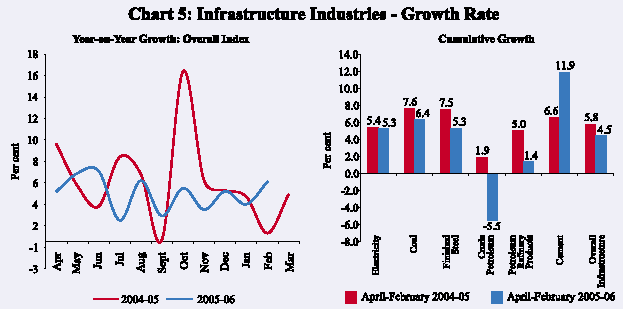
of crude petroleum and deceleration in growth in finished steel and petroleum refinery products. As noted earlier, decline in crude petroleum largely reflected the effects of fire at Mumbai-High oil field while deceleration in electricity could be attributed to shortage of coal and gas. Slowdown in steel sector could be attributed to decline in production of bars and rods, cold-rolled sheets and coils coupled with deceleration in steel exports. Cement production recorded strong growth, reflecting growing demand from the housing and the infrastructure sectors as well as higher exports – cement exports rose by 41.8 per cent during April-December 2005.
Business Expectations Surveys
Business expectations surveys conducted by various agencies suggest that the industrial sector is likely to continue its strong performance in the near term. Dun and Bradstreet’s composite business optimism index for the quarter January-March 2006 improved by 21.1 per cent over the same quarter of the previous year. The index, however, declined by 10.3 per cent over the previous quarter (October-December 2005) reflecting the base effect – the index was at an all time high in October-December 2005. According to the survey conducted in December 2005, business expectations remain high with around 90 per cent of the respondents expecting an increase in sales in the forthcoming quarter. Almost 85 per cent of the respondents anticipated higher profits and 46 per cent respondents were of the opinion that there would be an increase in their selling prices. According to FICCI’s latest Business Confidence Survey conducted during February 2006, the confidence level of the Indian corporate sector improved, with the Business Confidence Index recording its highest value in the last 15 quarters.
| Table 6: Business Expectations Surveys |
|||
| Agency |
Business Expectations |
Growth over |
|
| previous round |
|||
| Expectation for |
Index |
(Per cent) |
|
| 1 |
2 |
3 |
4 |
| Dun & Bradstreet |
January-March 2006 |
Business Optimism Index |
-10.3 |
| CII |
September 2005-March 2006 |
Business Confidence Index |
1.5 |
| FICCI |
April-September 2006 |
Business Confidence Index |
1.9 |
| NCAER |
January-June 2006 |
Business Confidence Index |
3.7 |
| RBI |
April-June 2006 |
Business Expectations Index |
-4.1 |
Results show an improvement in the respondents’ assessment of the current overall economic conditions as well as their perception of the country’s economic performance in the next six months. Amongst the three industry sectors – services, heavy industry and light industry – the services sector is the most optimistic with 90 per cent of the participating companies looking forward to a ‘moderately to substantially’ better performance of their sector in the coming two quarters followed by the light industry (78 per cent of the respondents) and the heavy industry (68 per cent of the respondents). Although the respondents anticipate some moderation in their sales, profits and exports, there are signs of a further pick-up in investments in the next six months. Nearly 71 per cent of the companies reported capacity utilisation in excess of 75 per cent (Table 6).
According to the Reserve Bank’s latest Industrial Outlook Survey conducted during January-February 2006, the Business Expectations Index, based on expectations for April-June 2006 quarter, declined by 4.1 per cent over the previous quarter (Chart 6). The index was, however, almost the same as a year
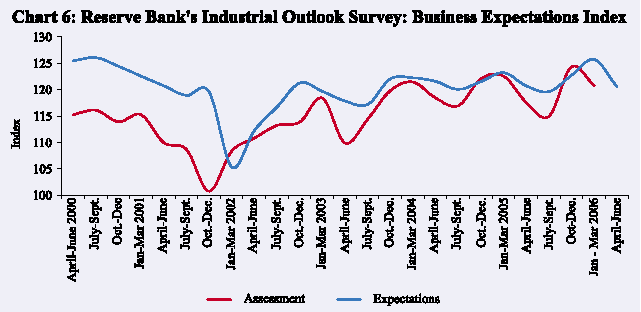
| Table 7: Net Response on ‘A Quarter Ahead’ Expectations about Industrial Performance Over the Latest |
|||||||
| (Per cent) |
|||||||
| April- |
July- |
Oct- |
Jan- |
April- |
|||
| Parameter |
Response |
June |
Sept. |
Dec. |
March |
June |
|
| 2005 |
2005 |
2005 |
2006 |
2006 |
|||
| (987) |
(816) |
(961) |
(934) |
(1086) |
|||
| 1 |
2 |
3 |
4 |
5 |
6 |
7 |
|
| 1. |
Overall business situation |
Better |
44.3 |
45.5 |
51.3 |
49.8 |
46.3 |
| 2. |
Financial situation |
Better |
36.7 |
36.7 |
42.3 |
40.7 |
40.4 |
| 3. |
Working capital finance requirement |
Increase |
27.2 |
28.8 |
32.7 |
31.9 |
30.6 |
| 4. |
Availability of finance |
Improve |
30.8 |
30.7 |
34.1 |
34.1 |
33.8 |
| 5. |
Production |
Increase |
38.7 |
40.7 |
46.9 |
46.3 |
42.5 |
| 6. |
Order books |
Increase |
37.4 |
39.6 |
43.7 |
41.0 |
39.1 |
| 7. |
Pending orders, if applicable |
Below normal |
– |
– |
0.8* |
-1.4 |
-0.1 |
| 8. |
Cost of raw material |
Decrease |
-36.7 |
-43.6 |
-30.0 |
-35.9 |
-37.3 |
| 9. |
Inventory of raw material |
Below average |
-4.3 |
-4.2 |
-6.9 |
-6.8 |
-5.0 |
| 10. |
Inventory of finished goods |
Below average |
-3.1 |
-4.2 |
-3.3 |
-4.7 |
-4.5 |
| 11. |
Capacity utilisation |
Increase |
27.7 |
25.4 |
31.1 |
29.6 |
24.8 |
| 12. |
Level of capacity utilisation |
Above normal |
8.1 |
7.6 |
10.9 |
11.4 |
9.4 |
| 13. |
Assessment of the production capacity |
More than adequate |
5.7 |
5.3 |
5.0 |
4.9 |
4.1 |
| 14. |
Employment in the company |
Increase |
7.7 |
7.8 |
12.7 |
13.3 |
14.5 |
| 15. |
Exports, if applicable |
Increase |
30.2 |
32.5 |
33.3 |
31.8 |
31.0 |
| 16. |
Imports, if any |
Increase |
20.3 |
23.7 |
19.2 |
20.8 |
22.7 |
| 17. |
Selling prices are expected to |
Increase |
11.0 |
13.3 |
7.8 |
10.8 |
12.4 |
| 18. |
If increase expected in selling prices |
Increase at lower rate |
13.5 |
14.0 |
16.6 |
16.3 |
12.0 |
| 19. |
Profit margin |
Increase |
6.3 |
7.1 |
9.6 |
12.6 |
9.3 |
| * : Question on Pending Orders was included in the July-September 2005 round. |
|||||||
ago. The expectations index based on the assessment for January-March 2006 also declined by 2.8 per cent over the previous quarter after showing a rise of 8.2 per cent during October-December 2005, the highest since the inception of the survey. Survey results indicate that the expectations of various indicators in April-June 2006 are better than that in the corresponding quarter of 2005 although lower than that in the immediately preceding quarter (Table 7).
Services Sector
Growth in the services sector accelerated to 9.9 per cent during April-December 2005 from 9.7 per cent during April-December 2004, benefiting from robust growth in the major sub-sectors viz., ‘trade, hotels, transport and communication’, ‘financing, insurance, real estate and business services’ and ‘construction’. The ‘trade, hotels, transport and communication’ sector recorded double-digit growth, benefiting from expansion in exports and imports,
| Table 8: Indicators of Service Sector Activity |
||
| (Growth rates in per cent) |
||
| Sub-sector |
April-January |
April-January |
| 2004-05 |
2005-06 |
|
| 1 |
2 |
3 |
| Tourist arrivals (April-February) |
23.7 |
11.7 |
| Commercial vehicles production (April-December) |
32.3 |
9.7 |
| Railway revenue earning freight traffic |
7.8 |
10.4 |
| New cell phone connections |
17.1 |
68.0 |
| Cargo handled at major ports |
10.8 |
11.7 |
| Civil aviation |
||
| a) Export cargo handled |
12.4 |
7.3 |
| b) Import cargo handled |
28.6 |
13.5 |
| c) Passengers handled at international terminals |
15.6 |
12.8 |
| d) Passengers handled at domestic terminals |
25.3 |
22.9 |
| Roads: Upgradation of Highways |
19.0 |
-20.9 |
| Cement (April-February) |
6.6 |
11.9 |
| Steel (April-February) |
7.5 |
5.3 |
| Aggregate deposits (end-March, year-on-year) |
14.8 |
16.9 |
| Non-food credit (end-March, year-on-year) |
28.8 |
30.8 |
| Central Government expenditure (April-February) |
5.6 |
1.7 |
improvement in performance indicators of railways, cargo handled at major ports as well as by civil aviation, passengers handled by civil aviation, rise in domestic and international tourism and robust growth in the cellular subscriber base (Table 8). Healthy growth in bank deposits, sustained acceleration in non-food credit and increased exports of information technology enabled services buoyed up the sub-sector ‘financing, insurance, real estate and business services’. Indian software and services continued to perform well.
Savings and Investment
Gross Domestic Saving (GDS), as per cent of GDP at current market prices, increased from 28.9 per cent in 2003-04 to 29.1 per cent in 2004-05, led by higher public sector saving resulting from lower dis-saving of public authorities and improvement in savings of non-departmental enterprises. Private corporate saving also improved reflecting higher profits. On the other hand, savings of the household sector declined by 1.5 percentage points during 2004-05 to 22.0 per cent. Although the overall savings rate increased by 0.2 percentage points of GDP, the overall investment rate increased by 2.9 percentage points of GDP to 30.1 per cent in 2004-05 reflecting a recourse to higher foreign savings – net capital inflows of 1.0 per cent of GDP in 2004-05 in contrast to net outflows of 1.6 per cent of GDP during 2003-04 (Table 9).
The buoyancy in manufacturing and services sector activities and the positive business confidence and expectations suggest that the recent growth
| Table 9: Gross Domestic Saving and Investment |
||||||||
| (Per cent of GDP at current market prices) |
||||||||
| 1999-00 |
2000-01 |
2001-02 |
2002-03 |
2003-04 |
2004-05 |
|||
| (PE) |
(QE) |
|||||||
| 1 |
2 |
3 |
4 |
5 |
6 |
7 |
||
| 1. |
Household Saving |
21.3 |
21.2 |
22.0 |
23.1 |
23.5 |
22.0 |
|
| of which : |
||||||||
| a) Financial Assets |
10.5 |
10.2 |
10.8 |
10.3 |
11.5 |
10.3 |
||
| b) Physical Assets |
10.7 |
11.0 |
11.2 |
12.7 |
12.0 |
11.7 |
||
| 2. |
Private Corporate Saving |
4.5 |
4.1 |
3.6 |
4.1 |
4.4 |
4.8 |
|
| 3. |
Public Sector Saving |
-0.9 |
-1.8 |
-2.0 |
-0.7 |
1.0 |
2.2 |
|
| 4. |
Gross Domestic Saving |
24.9 |
23.5 |
23.6 |
26.5 |
28.9 |
29.1 |
|
| 5. |
Net Capital Inflow |
1.1 |
0.6 |
-0.6 |
-1.2 |
-1.6 |
1.0 |
|
| 6. |
Gross Domestic Capital Formation |
26.0 |
24.2 |
23.0 |
25.3 |
27.2 |
30.1 |
|
| 7. |
Gross Capital Formation |
26.1 |
24.3 |
24.3 |
25.3 |
26.3 |
28.5 |
|
| of which : |
||||||||
| a) Public Sector |
7.5 |
6.9 |
6.9 |
6.2 |
6.5 |
7.2 |
||
| b) Private Corporate Sector |
7.2 |
5.7 |
5.6 |
5.8 |
6.8 |
8.2 |
||
| c) Household sector |
10.7 |
11.0 |
11.2 |
12.7 |
12.0 |
11.7 |
||
| d) Valuables+ |
0.8 |
0.7 |
0.6 |
0.6 |
0.9 |
1.3 |
||
| 8. |
Total Consumption Expenditure (a+b) |
77.5 |
76.6 |
76.7 |
74.7 |
73.5 |
71.8 |
|
| a) Private Final Consumption Expenditure |
64.6 |
64.1 |
64.5 |
62.9 |
62.4 |
60.6 |
||
| b) Government Final Consumption Expenditure |
12.9 |
12.5 |
12.3 |
11.8 |
11.2 |
11.3 |
||
| Memo: |
||||||||
| 9. |
Saving-Investment Balance (4-6) |
-1.1 |
-0.6 |
0.6 |
1.2 |
1.6 |
-1.0 |
|
| 10. Public Sector Balance# |
-8.3 |
-8.7 |
-8.9 |
-6.8 |
-5.5 |
-5.0 |
||
| 11. Private Sector Balance# |
7.8 |
8.6 |
8.8 |
8.6 |
9.0 |
6.9 |
||
| a) Private Corporate Sector |
-2.7 |
-1.6 |
-2.0 |
-1.7 |
-2.5 |
-3.4 |
||
| b) Household Sector |
10.5 |
10.2 |
10.8 |
10.3 |
11.5 |
10.3 |
||
| PE : Provisional Estimates. QE : Quick Estimates. |
||||||||
momentum in the Indian economy is likely to be maintained in 2006-07, as has also been projected by different agencies (Table 10).
| Table 10: Projections of Real Gross Domestic Product for India by Various Agencies: 2006-07 |
|||||||
| Agency |
Growth Projections for 2006-07 (Per cent) |
Month of Projections |
|||||
| Overall Growth |
Agriculture |
Industry |
Services |
||||
| 1 |
2 |
3 |
4 |
5 |
6 |
||
| ADB |
7.6 |
– |
– |
– |
April 2006 |
||
| CDE-DSE |
7.7 |
2.8 |
9.4 |
8.9 |
January 2006 |
||
| CMIE |
8.0 |
– |
– |
– |
March 2006 |
||
| ESCAP |
7.9 |
– |
– |
– |
March 2006 |
||
| ICRA |
7.4-8.2 |
2.0 |
8.2-9.7 |
9.1-9.7 |
January 2006 |
||
| IMF |
6.8 |
– |
– |
– |
February 2006 |
||
| Planning Commission* |
7.7 |
3.2 |
8.9 |
8.8 |
December 2005 |
||
| – : Not Available. |
|||||||























